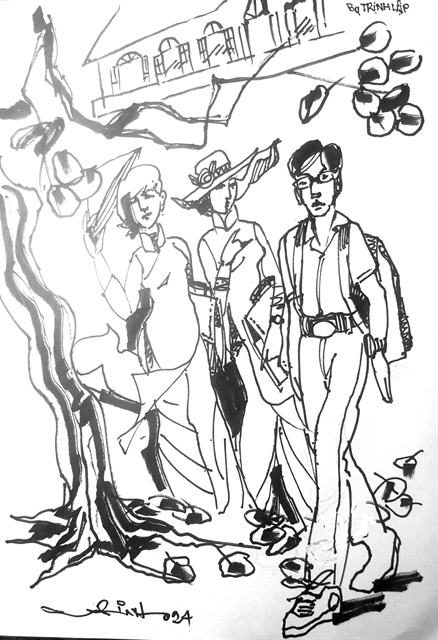 Talk Around Town
Talk Around Town

 |
| Ilustration by Trịnh Lập |
by Nguyễn Mỹ Hà
The iconic image of a Vietnamese lady wearing an áo dài (traditional long dress) with long pants and a conical hat is known worldwide. Some Vietnamese women today think it's a cliché and want to change that image, which they believe does not truly represent modern womanhood.
The debate that has divided both parents and students is over when it is a must for female teachers in primary, secondary and high schools to wear the traditional costume on important occasions throughout the year, such as the first and last day of the academic year, the first day after the Tết (Lunar New Year holiday) break, and all-school flag salute rituals on Monday morning, among others.
Students in primary and secondary schools do not have to wear the áo dài on any occasion, though some parents clad them in it on the first day back to school after Tết break.
High-school girls, however, have to follow their school dress code to wear all white áo dài for school on Monday, Wednesday and Friday. The majority of public schools in the cities require female students to wear the traditional outfit, though some public high schools do not have this rule.
Some public high schools in Hà Nội now have three sets of uniform: a week-day uniform, áo dài for special occasions, and sportswear. While the rest of the uniform receives approval from most people, the áo dài is a topic of some contention.
The first issue is that the design of áo dài is too tight, and not comfortable enough to wear in class. Secondly, when students travel on motorbikes, the back flap can get caught in the wheel, causing accidents.
The pro áo dài group, yours truly included, say that if it's a school rule, then you must follow it. When you wear it, you can still function normally, most of the time, except if you want to look rebellious in your peers' eyes and perform high kicks or something. As a student, you only wear it from home to school, then back, so it's manageable.
Adolescence is a delicate time of life. If a child feels she has been forced against her will, she can easily explode. If a talk can be held equally with teachers listening to their desires and opinions, they may be reluctant to follow rules, but at least their voices have been heard. Sometimes, a rebellious child only needs to be listened to.
But not all students want to abolish áo dài, and some girls love the attire and feel comfortable wearing it on bicycles and motorbikes.
A white áo dài has often been associated with innocence, tenderness and carefree youth. But as the saying goes, the outfit doesn't make the monk. Not everyone wearing a white áo dài is innocent or carefree, but white is both fashionable and pleasing to the eye on a hot summer's day.
While many students and families opt to use polyester as the material for the school áo dài (it's convenient, and easy to dry after rain) a silk white áo dài can be a treasure a mother or grandmother can gift to their daughter or grandchild.
If more schoolgirls use silk as fabric, then traditional silk-making villages may not be in danger of losing their age-old craft.
In Việt Nam the traditional outfit has not been associated with religious belief, or part of any spiritual teaching. Many locals maintain tradition against an invasion of Western ideas, comfort and hygiene standards. What we try to maintain as tradition today, may not be the same values that our grandparents wanted decades ago.
Then they wanted to keep the men's hair in a bun, wear long sleeves, and have long nails on literary men who didn't help their wives and children with the housework.
Today we want to keep the women's habit of wearing long dresses, and not everyone knows that today's áo dài came out of the creation of fashion designer Cát Tường, alias Le Mur, who made it to rebel against the stiff clothing codes of the 1930s. He wanted to liberate women's bodies by showing the curves under just one layer of thin fabric instead of several layers as was traditional.
As parents, we want our children to learn and maintain traditional values during their years in high school. When they come of age and get full voting rights at 18 years old, they can be as rebellious as they want.
For high-school students who do not want to wear white dresses, there are still schools that do not make it a dress code. If they pass the exam to go to these schools, they can be free to wear only regular uniforms as they wish. VNS




